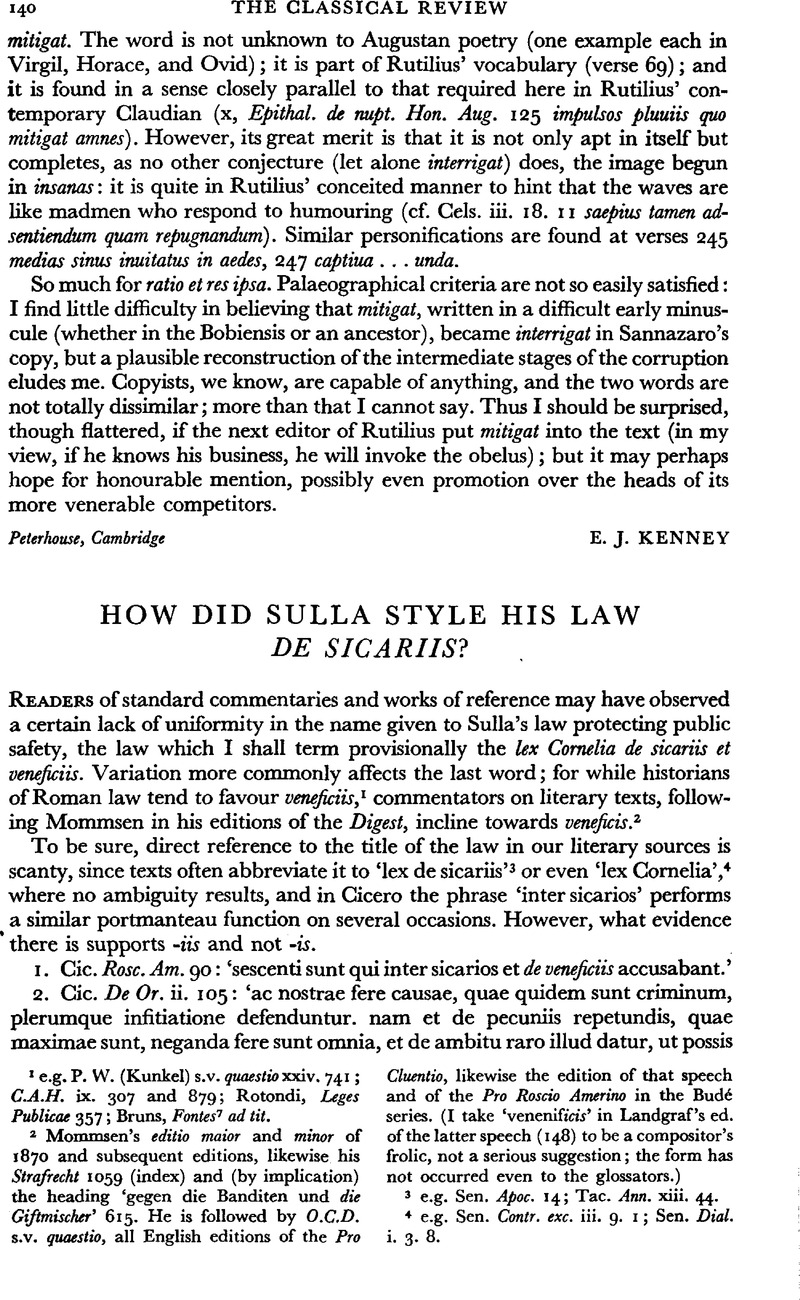Article contents
How did Sulla style his law de sicarus?
Published online by Cambridge University Press: 27 February 2009
Abstract

- Type
- Review Article
- Information
- Copyright
- Copyright © The Classical Association 1968
References
page 140 note 1 e.g. P. W. (Kunkel) s.v. qnaestio xxiv. 741; C.A.H. ix. 307 and 879; Rotondi, Leges Publicae 357; Bruns, Fontes7 ad tit.
page 140 note 2 Mommsen's editio maior and minor of 1870 and subsequent editions, likewise his Strafrecht 1059 (index) and (by implication) the heading ‘gegen die Banditen und die Giftmischer’ 615. He is followed by O.C.D. s.v. quaestio, all English editions of the ProCluentio, likewise the edition of that speech and of the Pro Roscio Amerino in the Bude series. (I take ‘venenificis’ in Landgraf's ed. of the latter speech (148) to be a compositor's frolic, not a serious suggestion; the form has not occurred even to the glossators.)
page 140 note 3 e.g. Sen. Apoc. 14; Tac. Ann. xiii. 44.
page 140 note 4 e.g. Sen. Contr. exc. iii. 9. 1; Sen. Dial. i. 3. 8.
page 141 note 1 C.I.L. vi. 1283, where C. Claudius Pulcher is named as having been ‘IVDEX. Q〈uaestionis〉. VENEFICIS’. The inscription is cited by Kunkel, Untersuchungen zur Entwicklung des römischen Kriminalverfahrens in vorsullanischer Zeit, 46.173. I am grateful to author, who drew my attention to this text.
page 141 note 2 viii. 18. 11; xxxix. 38. 3; xl. 43. 2, 44. 6.
page 141 note 3 e.g. xxxix. 41. 5. For the characteristic Silver Age use of the genitive, cf. Val. Max.ii. 5. 3; Tac. Ann. xii. 66; Plin. Ep. vii. 6. 8.
page 141 note 4 Where reference is made in Collatio i to the title of the lex Cornelia, of the manuscripts used by Mommsen and others to establish the text one (Berolinensis Lat. fol. 269) has always -is, another (Vercellensis 122) always -iis, the third (Vindobonensis 2160) twice -is and once -iis. In Cod. Theod. ix. 19. 4. 1 the manuscripts favour -iis and Mommsen prints it in his edition.
page 142 note 1 C.A.H. ix. 879. 2.
page 142 note 2 For examples cf. my note on Inter Sicarios below.
page 142 note 3 Dell'Oro, I libri de officio, 157, thinks that Coll. i. 3. 1 probably does preserve the original text of the law. But some of the wording is suspicious, e.g. ‘qui cum telo ambulaverit’ instead of ‘fuerit’, and it is always possible that some obsolete formula like ‘quei ex hace lege quaerat’ underlies qu. de sic. here. Ebrard, Zeitschrift der Savigny-Stiftung 46 (1926) 160. 3, is also doubtful.
page 142 note 4 Primarily Inst. iv. 18. 7, but Coll. viii. 5 and 7 and Paul. Sent. v. 25 ad tit. and 1 provide evidence for ‘testamentaria’, Paul. Sent. i. 12. 1, iv. 7. 1, v. 25. 11, Cod. Just. ix. 22 and Dig. xlviii. 10 for ‘de falsis’.
page 142 note 5 I am grateful to the directors of the Thesaurus for permitting me to check this and other points against their unpublished materials.
page 143 note 1 Two (Fin. ii. 54 and Inv. ii. 60) of the eight surviving examples of inter sic. are used in connection with pre-Sullan quaestiones, which suggests that the expression was already well established by 81.
page 143 note 2 98 (on sec. 21).
page 143 note 3 Cic. Cat. i. 8 (virtually repeated in Sull. 52): ‘dico te priore nocte venisse inter fat carios … in M. Laecae domum.’ Varro L.L. v. 154: ‘intumus Circus “ad Murciae” vocatur … ab urceis, quod is locus inter figulos esset.’ Livy xxxv. 41. 10: ‘iidem porticum extra portam trigeminam inter lignarios fecerunt.’ C.I.L. xiv. Supp. I. 4535. 3: ‘pars Circi inter vitores arsit.’ Possibly Fausset was unconsciously influenced by English analogies: there is no evidence to suggest that the qu. inter sic. always met in the same place, which thus gained ‘a quasi-local designation’.
- 1
- Cited by




